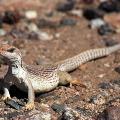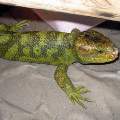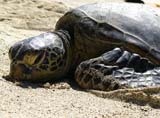
Desert iguana
The desert iguana Dipsosaurus dorsalis is adapted to not the best living conditions – constant drought and heat. In the genus Dipsosaurus, it is the only species found in southwestern North America. And in captivity, this lizard needs conditions close to natural – high temperatures and a dry climate. By the way, this rule also applies to many other iguanas that do not tolerate excessive moisture. Dipsosaurus is often kept in terrariums, since, compared to some reptiles, the desert iguana is absolutely not aggressive towards people and quickly gets used to them. It is easy to care for, easy to feed, and very interesting to watch the behavior of a Dipsosaurus in a terrarium. Desert iguanas are especially agile and thermophilic. They are unusually fast, nimble creatures, and when at rest, they prefer to bask in the sun. By the way, the generic name of lizards Dipsosaurus is directly related to their natural endurance and is derived from two Greek words “Dipsa” (δίψα) “thirst “, and”sauros ” (σαῦρος) “lizard”. In a free translation – a lizard that is not afraid of thirst. And besides thirst, the desert iguana is not afraid of people either. Travelers in North America often happened to observe how this lizard, quickly moving its paws, crosses the road in front of the car. It moves bizarrely, widely setting aside its hind legs, and the front, on the contrary, pressing it to the body.
Contents
Classification
Kingdom: Animals
Type: Chord
Class: Reptiles
Order: Scaly
Suborder: Lizards
Family: Iguana
Genus Desert iguana Dipsosaurus
Species Dipsosaurus dorsalis
Appearance
 Desert iguanas are not very large lizards. The standard length of their body is about 14 cm, but sometimes 40 cm giants are also found. The body of this reptile is quite dense, turning into the same thick tail, rounded in cross section and thinning towards the end. There is also a spinal ridge of large horny scales. The color of the body in different individuals of desert iguanas can vary, but brown and gray tones remain the predominant colors. True, there are also lighter reptiles – fawn, cream, pale gray. However, the lizard is not monophonic. On the sides and on the back, its body is usually decorated with white spots with a black border, which turn into a solid mesh closer to the tail, and there are brown spots on the hind legs. The tail is lighter in comparison with the body and also has a pattern of dark transverse stripes.
Desert iguanas are not very large lizards. The standard length of their body is about 14 cm, but sometimes 40 cm giants are also found. The body of this reptile is quite dense, turning into the same thick tail, rounded in cross section and thinning towards the end. There is also a spinal ridge of large horny scales. The color of the body in different individuals of desert iguanas can vary, but brown and gray tones remain the predominant colors. True, there are also lighter reptiles – fawn, cream, pale gray. However, the lizard is not monophonic. On the sides and on the back, its body is usually decorated with white spots with a black border, which turn into a solid mesh closer to the tail, and there are brown spots on the hind legs. The tail is lighter in comparison with the body and also has a pattern of dark transverse stripes.
In fact, the color of iguanas often depends on the surrounding area, as it performs a camouflage function. The same applies to desert reptiles, even within the same species. And they can change color depending on the ambient temperature. In the mornings, when the sun is still sparing, the desert iguana is darker, but as the ambient temperature rises and, accordingly, the internal temperature of the lizard, its body turns pale. And it is also common for reptiles to expose darker parts of the body to the sun, as they absorb heat better.
The head of the desert iguana is small, slightly blunt in shape, with large ear holes, and the body is shaped like a cylinder, supported by four strong paws adapted for fast running. The teeth of the lizard are not sharp, adapted more for pinching than for biting. And during the breeding season, it is characterized by such an interesting feature as a color change. Both sexes of desert iguanas develop pinkish or reddish tones in body tones.
Young iguanas are much more contrastingly colored than adults. People especially appreciate these reptiles as pets for their good looks. From the side, the pattern on the skin of a desert iguana may resemble a serpentine one, the head is somewhat similar to a frog, and the almond-shaped eyes seem to be outlined with a dark pencil, which makes them seem even more elongated. In general, the muzzle of dipsosaurs gives the impression of being very quick-witted. These iguanas are akin to domestic cats, they can become affectionate, trusting, easy to handle and open to care and communication creatures.
Distribution and habitation
Desert iguanas inhabit the North American continent, in particular, its western territories, for example, such states as Nevada, Arizona, California. Further, the range continues south and covers Mexico on both sides of the Gulf of California, as well as the nearest islands. Habitat conditions suitable for desert iguanas, respectively, sandy soils with rare shrubs. But people happened to meet a lizard in the mountains, and on the rocks, and on the rocky plains. In general, the desert iguana is the most common species of reptile on the mainland. She can also live where poisonous creosote bushes grow – this does not bother her at all. And sometimes desert iguanas are found in tropical deciduous forests. The surrounding vegetation, even sparse desert, serves as a lizard for protection and shelter. Although, in case of serious danger, the desert iguana will, of course, prefer to hide in a hole that she digs herself in the sandy mounds that grow around the bushes. It is also common for a lizard to use other people’s holes, for example, fox or turtle. Another desert iguana can settle in a sand dune or an old dry river bed.
Behavior and lifestyle
The desert iguana is a lover of open spaces and freedom, therefore it is recommended to choose a terrarium for it that is wider than high. These lizards are very fond of digging, so in artificial conditions they need suitable soil, such as quartz sand. In addition, it is important for reptiles to create suitable conditions for climbing, since in the wild they often climb mountainous and hilly areas in search of plant food. In nature, desert iguanas live in a hot and dry climate, it is desirable to form the same in a terrarium. To do this, it is enough to maintain a constant temperature at the level of 30-33 degrees. And where the lizard will take sunbaths, which it usually does very often, you can provide heating up to 40 degrees. If these conditions are not observed, then the reptile can get sick, as scientists have found that normal digestion occurs only at high temperatures in desert iguanas. And in no case should you create excessive moisture in the terrarium. In nature, these lizards simply do not need it, they do not drink, but replenish the body’s water reserves with the help of juicy food or licking moisture from the leaves.
Scientists have also discovered an interesting feature of the vision of desert iguanas. In laboratory conditions, the researchers imitated the shadow of a predator, and the lizards, noticing it, immediately rushed to the shelter. They do the same in the wild. As a result of the experiment, it was found that desert iguanas in search of shelter are able to navigate by the angle of polarization of light.
Another amazing feature of these lizards is heat transfer. On the hottest days, they open their mouths and breathe frequently, just as, for example, dogs do. So desert iguanas are not at all afraid of the heat and are active even when other reptiles are hiding from the scorching sun in burrows. Their body temperature is approximately 45 degrees, which is much higher than the life temperature threshold for other lizards.
The main occupation of desert iguanas during the day is wandering in search of food. In relation to relatives, reptiles rarely show aggression, this is only possible during the mating season. They hide in burrows at night or in case of danger, moreover, a hole dug by a desert iguana can have a rather complex internal structure – with a central chamber and several exits. And when the lizard hides in a hole, it throws sand at the entrance to it for greater reliability. So the shelter of the lizard becomes completely protected from predators and from heat losses. However, birds of prey, foxes, ferrets, some species of snakes still often prey on desert iguanas and ruin their nests. And sometimes people participate in such a hunt.
Food
Desert iguanas are naturally vegetarian, although vegetation in their habitats is usually sparse and low in nutrition. However, if the lizard manages to find any plant with bright flowers or fruits, they will be eaten immediately. In captivity, it is also recommended to feed desert iguanas with plant foods. Salads, vegetable mixes, various greens, grated fruits with vitamin supplements are suitable. But animal food is not recommended at all. She can only feed very young iguanas, and then no more than once a week. This happens in nature too. Young animals still catch insects, but adult lizards switch completely to a vegetable diet.
For desert iguanas, even the yellow flowers of creosote bushes, a plant that is poisonous to other animals, are attractive. Some reptiles are prone to coprophagy, cannibalism towards smaller lizards, or carrion eating, but this is quite rare in dipsosaurs. Of course, these lizards are more accustomed to dry food, however, in artificial conditions, such a strict diet should not be created for them. The main thing to remember is that desert iguanas do not need much water, so you can add succulent foods in small quantities to the diet.
Reproduction
 The mating season for desert iguanas begins in early spring. They lay no more often than once per season. There are also marriage courtships. Zoologists even suggest that desert iguanas are monogamous during the season, since in nature more than once it was necessary to observe a pair of lizards together. But the time of mating, laying and the appearance of young animals can vary depending on the habitats – southern and northern, and sometimes it changes slightly in the same individuals every year.
The mating season for desert iguanas begins in early spring. They lay no more often than once per season. There are also marriage courtships. Zoologists even suggest that desert iguanas are monogamous during the season, since in nature more than once it was necessary to observe a pair of lizards together. But the time of mating, laying and the appearance of young animals can vary depending on the habitats – southern and northern, and sometimes it changes slightly in the same individuals every year.
The approximate number of eggs in a desert iguana is 3-8 in a clutch. The chicks hatch between the end of July and September. During breeding, adult desert iguanas do not actively hunt for food, but are concentrated on reproducing their own kind, so competition for limited food resources at this time decreases.
Desert iguanas also show another unique feature during the breeding season. We have already mentioned their extraordinary vision. In part, it is involved in the search for an individual of the opposite sex. Many reptiles from the femoral pores secrete special substances, pheromones, by which male and female individuals find each other. But in desert conditions, such marks are poorly preserved, since any odors evaporate very quickly under the influence of high temperatures. And desert iguanas, along with an odorous trail, also leave special secretions, which, thanks to heavy molecules, create a label that absorbs light in the ultraviolet region. On this trail, males and females just orient themselves.
Sources of
http://www.terraria.ru/
http://www.apus.ru/
http://en.wikipedia.org
http://www.californiaherps.com/
http://digital-desert.com





